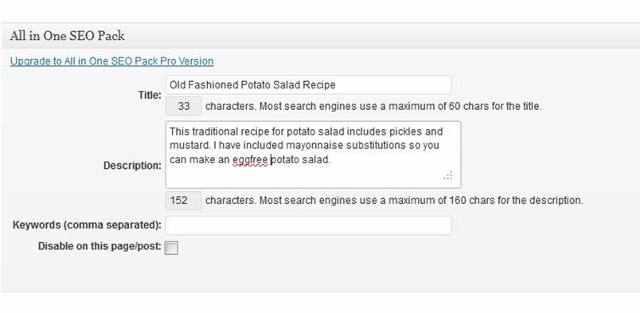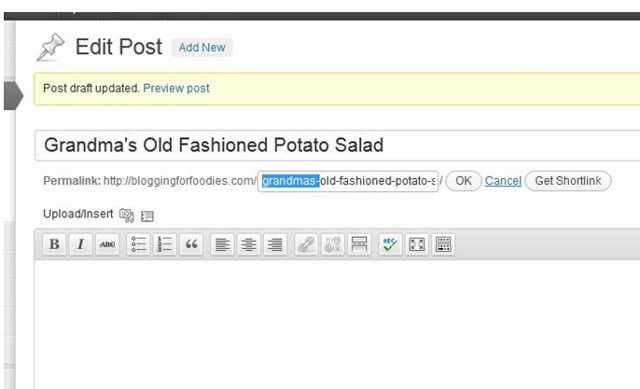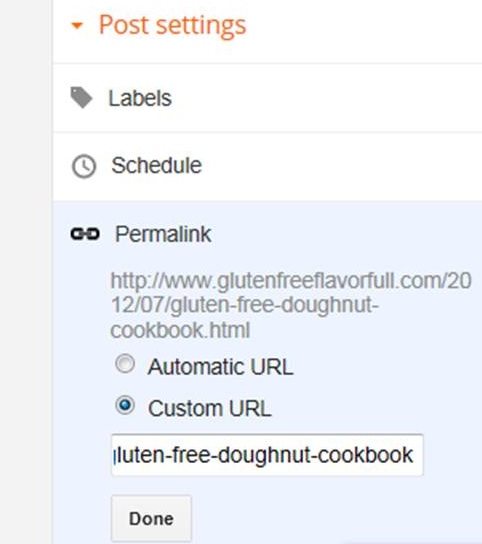You know some of your posts are gems and you’ve shared some great recipes, so why aren’t more people showing up to your blog? Your titles are catchy. They’re interesting and funny.
And that could be part of your problem!
If you want more traffic for your food blog, you need to make it easier for people to find your content while doing a Google search. Catchy titles might actually make it harder for people to find your content. Your title will not help you in Google searches unless it contains the words that people use when they are searching on a topic. If you used a play on words or song lyrics or put a hook in your title, you may be accidentally sabotaging your blog. And if your funny title does generate some traffic, those viewers might have been looking for something funny and be quite disappointed with a recipe for broiled tomatoes.
A Tale of Two Posts
In real life I am a goofball and that crops up at the oddest times when I blog. In the early years, it often appeared in my post titles. I would write a totally serious post and then on a whim give it a ridiculous title. Which is how my post on making French Vanilla Creamer ended up being called “Making Your Own Legal Stimulants“. My regular readers didn’t have a problem with my title and even shared it with their friends, so I received a little traffic. But a few weeks down the road, I started noticing traffic coming from Google searches for “how to make legal stimulants”. I am pretty sure anyone who arrives at my creamer post from a search on stimulants is very disappointed. Since those people are not finding what they are looking for, they are not going to look through my other posts and they are certainly not going to subscribe.
Three years after sharing my creamer recipe, I decided to share it again. This time I kept all of my goofiness inside my post and even though it contains at least one drug reference, I named the post Homemade French Vanilla Creamer. I realize that most of the people who arrive through Google searches skip over my silly story and go right to the recipe, but that is okay, because they find what they are looking for, like it enough to share the post, they view my other recipes, drop me a note, and occasionally subscribe to my blog.
All traffic is not created equal
If you have been around the blog world for any time then you have heard the term Search Engine Optimization (SEO) bandied about. SEO refers to a web site or blog page’s visibility in search results. The higher your post comes up in search results, the more likely it is to receive traffic. For a long time both of the posts I mentioned above were in the first 10 results produced by a Google search using terms in the post titles. Being in the top 10 seems like a good place to be, but it isn’t if you are there based on key words that do not match your post’s contents or your blog’s philosophy or mission.
Food Bloggers Don’t Need a Device to Hook their Readers
Many bloggers use a device, technique, or hook in their articles’ titles because they are trying to stand out from the pack. Or they are trying to create “buzz”. As food bloggers, we don’t have to do that. Growling tummies create more than enough buzz and while some recipes are seasonal, food never goes out of style. Everybody eats, but few people know how to cook, so we don’t have to worry about our niche becoming overpopulated. We just have to worry about helping people who like our cooking style find us. Every day millions of people are searching Google to figure out what to make for dinner that night. If you have buried your potato salad recipe under the title “A Walk in the Park” and a post about a family picnic, those people searching for a potato salad recipe are not going to find it on your site.
You have to make a decision: Are you a food blogger who shares stories with your recipes or are you a lifestyle blogger who peppers your stories with recipes. If you are the former, own it and give yourself permission to title your posts with recipe names, i.e. Easy Potato Salad, Italian Potato Salad, Potato Salad with Zucchini, or Old Fashioned Potato Salad.
The words, terms, and phrases that people enter in the box when they search on a topic are referred to as key words. When you select a title for your posts, think about what your post contains that people may be searching for and work those words into your title. You don’t have to use a formula and it doesn’t have to be a perfect match, but your post title should convey the essence of what is important to a searcher in your post.
If I had put some thought into my post title on creamer, I would have named it “How to Make French Vanilla Coffee Creamer” because it contains more of the words people use when searching for how to make coffee creamer and allows for more combinations of those words, but the second title is good enough to be of use to searchers. You don’t need to stress too much about trying to get titles perfect because there are still opportunities to use key words in the post (and I will talk about those later this week). Just take a minute before you hit publish to reflect on whether your title will help someone find your recipe.
If your blog is on WordPress you can do a couple of things to tinker with your title and improve SEO. The first thing you can do is edit your title.
Do you refer to your potato salad as Grandma’s recipe. Go ahead and call your recipe by its name in your post title, but then edit out the word Grandma in your permalink, since “grandma” is probably not going to be included in any Google searches for potato salad.
How to Edit Your Post Title in WordPress:
Write your post title. Then hit Save Draft.
Underneath your post title is the Permalink. Click on the edit button at the end of the permalink.
Highlight the words you want to remove, plus any excess dashes and hit the delete button. Now click on the OK button and you have a new permalink.
If you are using WordPress, you can also use the All in One SEO Pack Plugin to change how your post looks in search engines. If you are new to WordPress this is a great tutorial on how to implement the All in One SEO Pack Plugin.
Since many people include the word “recipe” in searches for recipes, I use the All in One SEO Pack to add Recipe to my title in search results. I can also include information in the description to help searches see what is unique about my recipe or see that it includes certain ingredients or avoids allergens.
How to Create a Custom Permalink for Blogger Posts:
The latest version of Blogger allows you to create a custom permalink. Thanks Micha of Cookin’ Mimi for sharing this tip in the comments!
To edit your permalink, click on Post Settings (on the right side when editing your post).
Scroll down and click on Permalink.
Click on custom URL.
Type your custom URL in the text box. Be sure to put a dash between each word: old-fashioned-potato-salad
Click on Done.
Although I am not sharing a recipe today, I still followed my advice for writing a post title. I didn’t succumb to my desire to use “A Tale of Two Posts” as my blog title, instead I summed up the essence of what this post is about in my title. I reread the post and thought I sounded a little bossy, since I’m too lazy to go back and change my tone I decided to phrase the title in the form of a directive.
If you want input as you create blog titles, ask for help from fellow foodies on the Blogging for Foodies Facebook Page.
Confession time: What is your craziest post title? Make me feel a little better about my “legal stimulants” and share your wildest post title in the comments.

